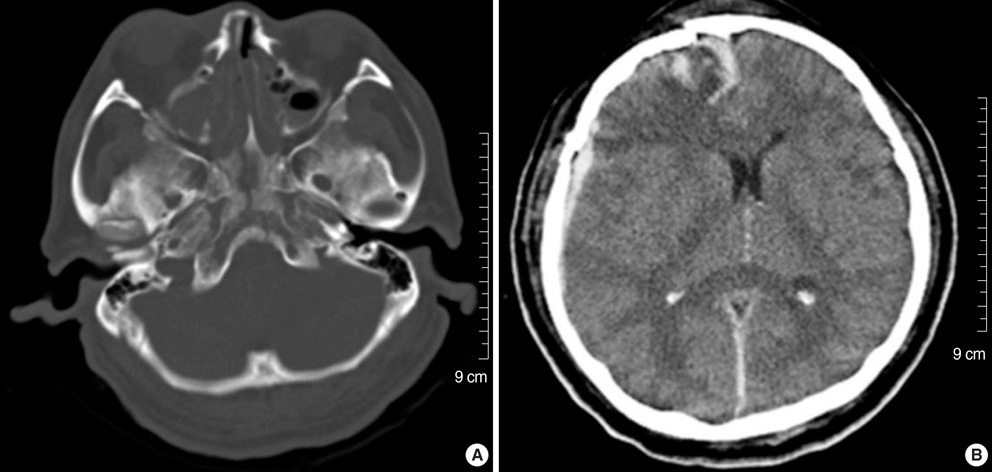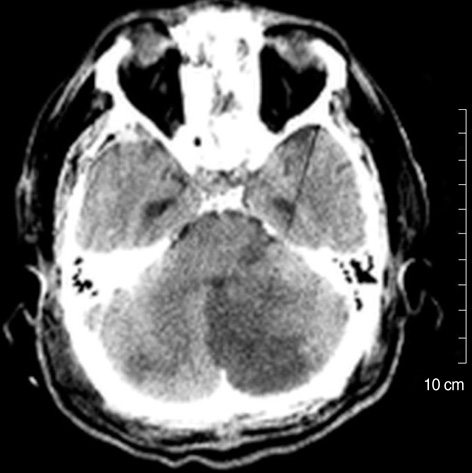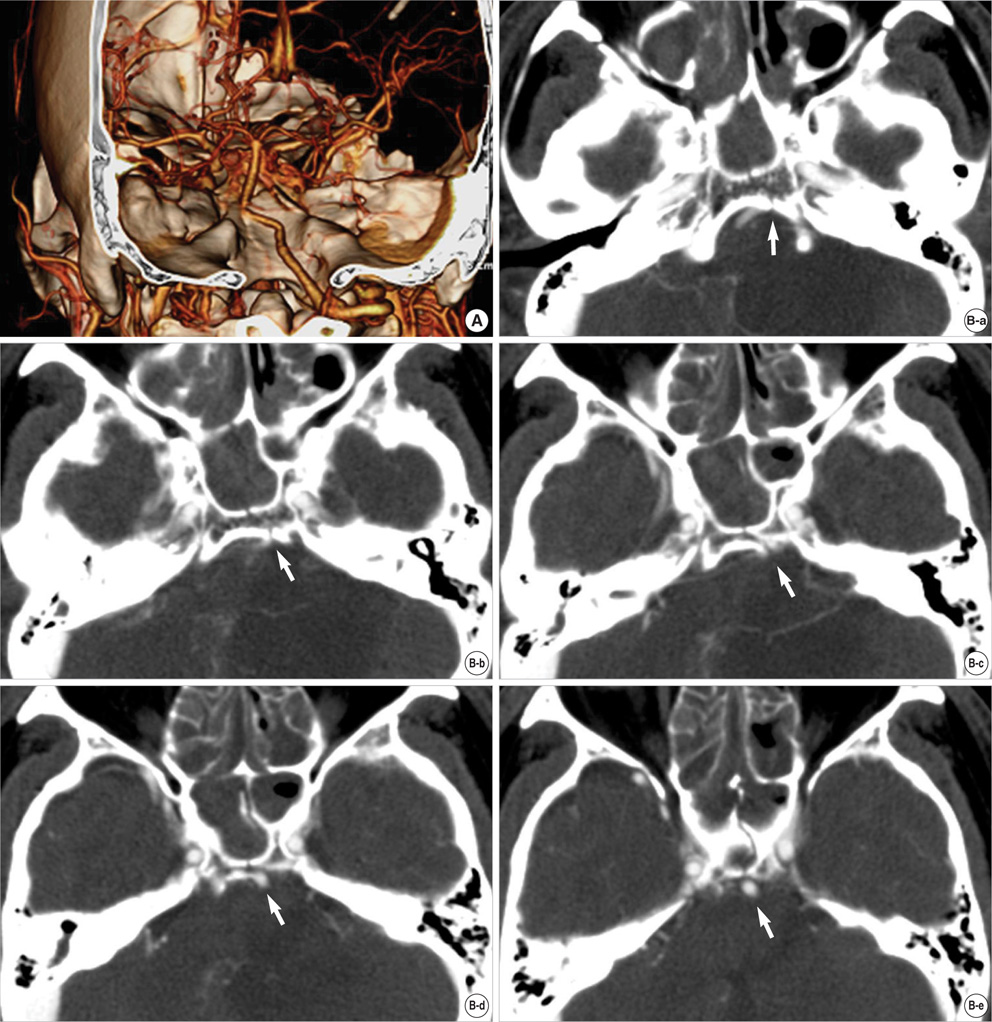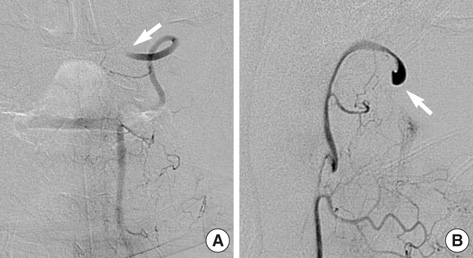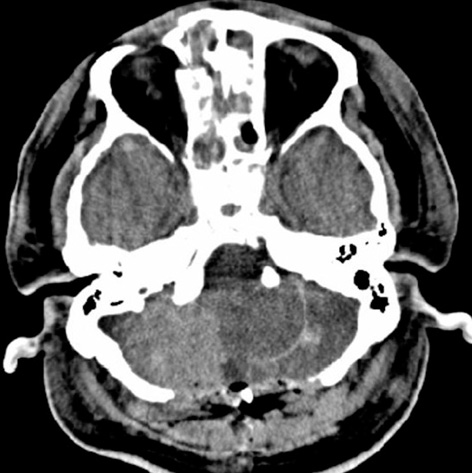J Korean Med Sci.
2008 Aug;23(4):747-751. 10.3346/jkms.2008.23.4.747.
Traumatic Entrapment of the Vertebrobasilar Junction Due to a Longitudinal Clival Fracture: A Case Report
- Affiliations
-
- 1Department of Neurosurgery, Konkuk University Hospital, Seoul, Korea. ctmoon@kuh.ac.kr
- 2Department of Radiology, Konkuk University Hospital, Seoul, Korea.
- KMID: 1785844
- DOI: http://doi.org/10.3346/jkms.2008.23.4.747
Abstract
- Vertebrobasilar junction entrapment due to a clivus fracture is a rare clinical observation. The present case report describes a 54-yr-old man who sustained a major craniofacial injury. The patient displayed a stuporous mental state (Glasgow Coma Scale [GCS]=8) and left hemiparesis (Grade 3). The initial computed tomography (CT) scan revealed a right subdural hemorrhage in the frontotemporal region, with a midline shift and longitudinal clival fracture. A decompressive craniectomy with removal of the hematoma was performed. Two days after surgery, a follow-up CT scan showed cerebellar and brain stem infarction, and a CT angiogram revealed occlusion of the left vertebral artery and entrapment of vertebrobasilar junction by the clival fracture. A decompressive suboccipital craniectomy was performed and the patient gradually recovered. This appears to be a rare case of traumatic vertebrobasilar junction entrapment due to a longitudinal clival fracture, including a cerebellar infarction caused by a left vertebral artery occlusion. A literature review is provided.
MeSH Terms
Figure
Reference
-
1. Joslyn JN, Mirvis SE, Markowitz B. Complex fractures of the clivus: Diagnosis with CT and clinical outcome in 11 patients. Radiology. 1988. 166:817–821.
Article2. Corradino G, Wolf AL, Mirvis S, Joslyn J. Fractures of the clivus: Classification and clinical features. Neurosurgery. 1990. 27:592–596.
Article3. Sights WP Jr. Incarceration of the basilar artery in a fracture of the clivus. case report. J Neurosurg. 1968. 28:588–591.4. Lindenberg R. Incarceration of a vertebral artery in the cleft of a longitudinal fracture of the skull. case report. J Neurosurg. 1966. 24:908–910.5. Loop JW, White LE Jr, Shaw CM. Traumatic occlusion of the basilar artery within a clivus fracture. Radiology. 1964. 83:36–40.
Article6. Anthony DC, Atwater SK, Rozear MP, Burger PC. Occlusion of the basilar artery within a fracture of the clivus. case report. J Neurosurg. 1987. 66:929–931.7. Shaw CM, Alvord EC Jr. Injury of the basilar artery associated with closed head trauma. J Neurol Neurosurg Psychiatry. 1972. 35:247–257.
Article8. Sato H, Sakai T, Uemura K. A case of incarceration of the vertebral and basilar arteries in a longitudinal fracture of the clivus. No Shinkei Geka. 1990. 18:1147–1150.9. Sato S, Iida H, Hirayama H, Endo M, Ohwada T, Fujii K. Traumatic basilar artery occlusion caused by a fracture of the clivus-case report. Neurol Med Chir (Tokyo). 2001. 41:541–544.10. Zhu BL, Quan L, Ishida K, Taniguchi M, Oritani S, Fujita MQ, Maeda H. Longitudinal brainstem laceration associated with complex basilar skull fractures due to a fall: an autopsy case. Forensic Sci Int. 2002. 126:40–42.
Article11. Sato M, Kodama N, Yamaguchi K. Post-traumatic brain stem distortion: a case report. Surg Neurol. 1999. 51:613–616.
Article12. Guha A, Fazl M, Cooper PW. Isolated basilar artery occlusion associated with a clivus fracture. Can J Neurol Sci. 1989. 16:81–83.
Article13. Taguchi Y, Matsuzawa M, Morishima H, Ono H, Oshima K, Hayakawa M. Incarceration of the basilar artery in a longitudinal fracture of the clivus: case report and literature review. J Trauma. 2000. 48:1148–1152.
Article14. Bala A, Knuckey N, Wong G, Lee GY. Longitudinal clivus fracture associated with trapped basilar artery: unusual survival with good neurological recovery. J Clin Neurosci. 2004. 11:660–663.
Article15. Menku A, Koc RK, Tucer B, Durak AC, Akdemir H. Clivus fractures: clinical presentations and courses. Neurosurg Rev. 2004. 27:194–198.
Article
- Full Text Links
- Actions
-
Cited
- CITED
-
- Close
- Share
- Similar articles
-
- Traumatic Rupture of the Extensor Pollicis Longus Tendon Associated with Smiths Fracture: A case report
- Isolated clival subdural haemorrhage from a dolicoectactic vertebrobasilar aneurysm: Case report and overview of endovascular treatment strategies
- Maigne Syndrome and Thoracolumbar Compression Fracture – An Overlooked Combination in Low Back Pain: A Case Report
- A Case of Huge Clival Meningioma: Case Report
- Giant Vertebrobasilar Junction Aneurysm Treated with Proximal Occlusion of Parent Artery Followed by Coil Embolization of Partially Thrombosed Aneurysm: A Case Report

